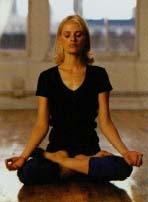Relaxation
Relaxation marks a state of ease or rest, often associated with a freedom from routine or work and freedom from stress.
KEYWORDS
for searching the Internet and other reference sources
Stress
Stress Management
Meditation
Yoga
A hot, bubbly bath may ease stress for Shanna, while an on-your-toes racquet ball game releases the day's tensions for Wayne. Maria finds that hot cocoa with a friend is "pure relaxation" and the antidote to stress. Ways to relax are countless. On weekends, city parks teem with children and adults pursuing relaxation as they play chess, practice tai chi * , jog, bicycle, kick soccer balls, shoot baskets, and sit on park benches to read. Still, one person's form of relaxation may be stressful to another.
What Is the Relaxation Response?
The Harvard professor of medicine Herbert Benson reported in the 1970s that the body has the capacity to achieve a special relaxed state, the direct opposite of the state of stress. Benson called this state the "relaxation response" and found that it can easily be achieved through meditation. The relaxation response involves a deep state of rest associated with decreases in heart rate, breathing rate, blood pressure, muscle tension, metabolism * , oxygen consumption, and active thinking. With daily practice of 20 to 30 minutes, the relaxation response reportedly can help keep the body young and the mind alert and might help increase energy, improve concentration, and extend memory.
What Are Other Forms of Relaxation?
There are other ways to achieve a state of deep relaxation. These include abdominal breathing, progressive muscle relaxation, yoga, and creative imagery.
Abdominal breathing
Practicing abdominal breathing (from deep in the stomach) can lead to a state of extreme relaxation. This kind of breathing differs from shallow chest breathing, or panting, which actually can cause an increase in nervousness. Abdominal breathing is the kind of breathing that is practiced in meditation or yoga.
* tai chi (ty chee) is an ancient Chinese system of body movements, practiced as a meditative form of exercise.
* metabolism (me-TA-bo-li-zum) is the chemical processes in the body that convert foods into the energy needed for body functions.
* phobias (FO-bee-as) are Intense, unrealistic fears of certain objects or situations.
Progressive muscle relaxation
Progressive muscle relaxation was developed in the early twentieth century by Dr. Edmund Jacobson. It is a program of tensing and relaxing muscles in an organized pattern so that that body "learns" how to release muscular tension. This form of relaxation can be paired with the gradual presentation of feared objects or ideas to help reduce phobias * or anxiety. When it is used in this way it is called systematic desensitization.
Yoga
Yoga is a system of mental and physical exercise that focuses the mind to eliminate distractions. There are various forms of yoga practice, but stages of the training often involve disciplined behavior, mastery of bodily posture, control of breathing, and meditation. In particular, hatha yoga, which focuses on bodily postures and control of breathing, is believed to improve the overall health of the body.

Creative imagery
There are various forms of creative imagery, including guided imagery, in which a therapist or other person describes peaceful scenes or images that create a restful, relaxed state. In some instances, people may form a mental picture of their own place of relaxation. This procedure often is used to lessen the pain and worry of medical procedures. For example, to diminish the pain of needles during injections for kidney disease, 9-year old Luke pictures himself walking on the sands of the beaches of Hawaii, as he did when he was 5 years old, before his illness began. In some instances, self-instruction may be used ("With every breath I take, I relax more deeply") to intensify the relaxation.
Conclusion
The human stress response occurs when people face situations that they perceive as dangerous, difficult, or overwhelming. Anxiety or other psychological symptoms may develop when people believe that inner or outer resources for coping with these stressful aspects of life are lacking or unavailable. The relaxation response is the physiological opposite of stress and can counteract its effects. Effective relaxation restores a person's ability to cope with life's daily hassles and stresses.
See also
Hypnosis
Phobias
Resilience
Stress
Resources
Book
Hipp, Earl. Fighting Invisible Tigers: A Stress Management Guide for Teens. Minneapolis: Free Spirit Publishing, 1996. For ages 11 and up.
Organization
www.KidsHealth.org
, a website sponsored by the Nemours Foundation and the Alfred I. duPont
Hospital for Children, has an article called "Spotlight on
Stress" that talks about relaxation.
http://kidshealth.org/teen/mind_matters/feelings/stress.html
Comment about this article, ask questions, or add new information about this topic: